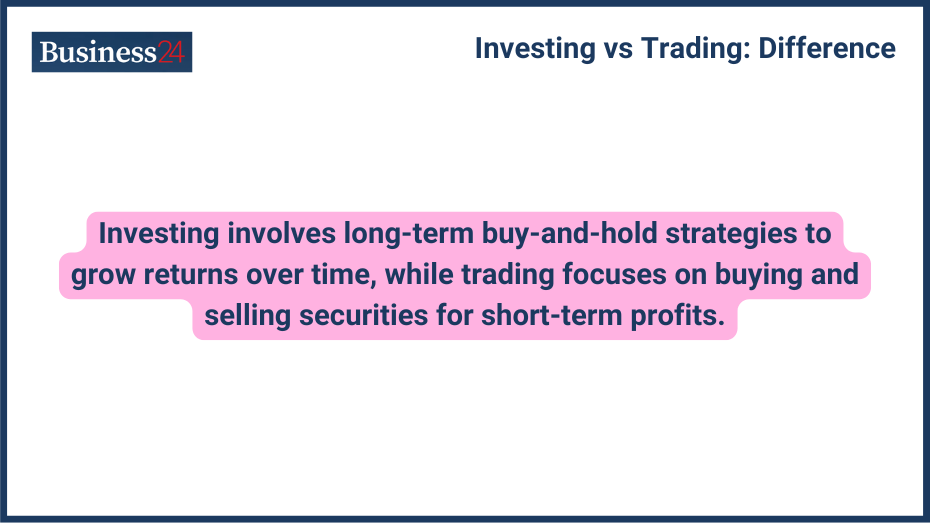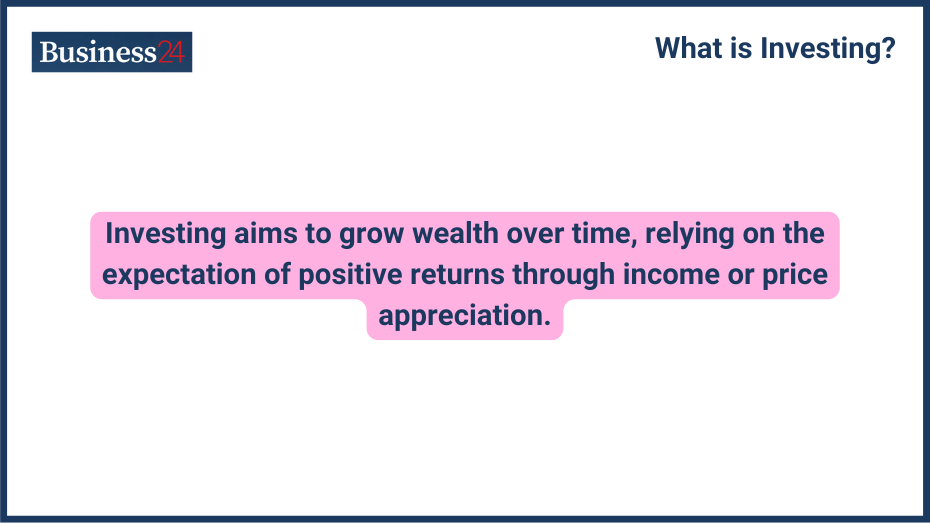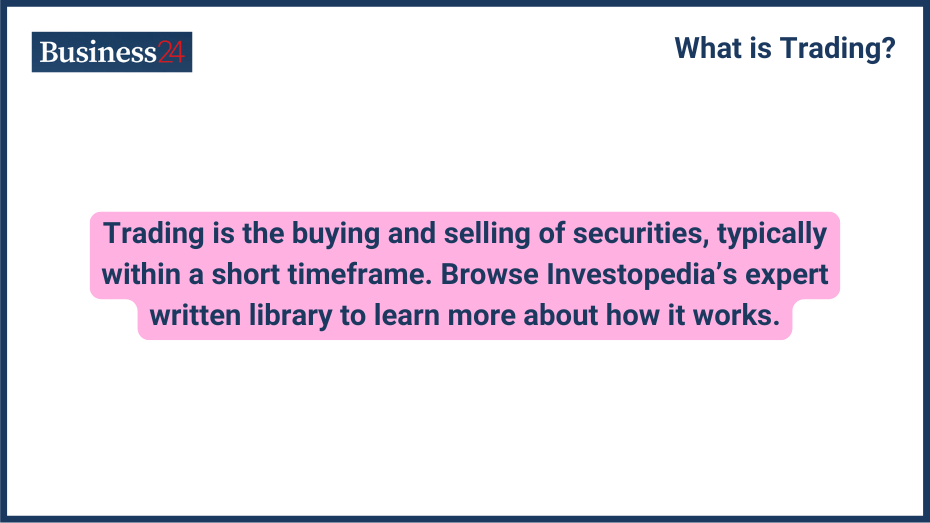
Investing involves long-term buy-and-hold strategies to grow returns over time, while trading focuses on buying and selling securities for short-term profits.
Although the goal is the same—making money—trading and investing differ in fundamental strategies, time horizons, and risk profiles. Understanding the distinction is crucial to creating strategies, managing risk, and achieving financial goals.
When investing, we buy assets (like stocks, mutual funds, bonds, or real estate) and hold them for long periods of time, usually a couple of years or even decades. Trading involves buying and selling financial assets more frequently, months, weeks, or even minutes. The goal of trading is to profit by taking advantage of shorter-term price fluctuations, whereas when investing, one seeks to build wealth gradually.
What is Investing?

Investment is a long-term game. Investors believe that with the growth of the economy and new innovations in the world, the general trend of the markets will be an uptrend, even though there will be some volatility in the shorter time periods.
The buy-and-hold strategy is one of the simplest and most effective ways to generate long-term wealth. This strategy involves holding the purchased assets through short-term market fluctuations and not reacting to market noise to make profits in the long term.
The belief is that markets will continue to grow over long periods, and strong investments will increase in value along with economic growth. This strategy demands patience, discipline, and trust in the market’s long-term uptrend. It also reduces the transaction costs of purchasing and selling assets, as transactions are not done frequently.
But compounding is where the buy-and-hold strategy shines. Compound is like the snowball effect; the gains are exponential. You can earn returns on your returns by reinvesting the dividends you get from stocks or interest from bonds.
Let’s say you invested $1000 in a stock that gives a return of 7% per year. After the first year, your investment grows to $1,070. In the second year, you will earn 7% on $1070, increasing your investment to $1144.90. Every year, your returns will get reinvested and continue to grow, earning more and more interest on your expanding total.
The longer you stay invested, the more obvious the compounding effect becomes. Even small amounts left invested for long periods can grow significantly due to compounding.
Common investment assets (stocks, bonds, mutual funds, ETFs)
There are diverse assets that an investor can choose from, and each of them comes with their own risk and return profile. These include :
- Stocks: These represent ownership in a company. Owning stocks entitles a person to receive a portion of the company’s profits.
- Bonds are debt instruments issued by corporations or the government. They offer fixed interest payments to the investor over a specified period.
- Mutual Funds are investment funds that pool investors’ money to acquire diversified holdings. Professionals manage them, and individual investors can diversify their capital across various assets.
- Exchange-Traded Funds (ETFs): These are similar to mutual funds but differ from them because they are traded on stock exchanges. They offer more flexibility and lower fees than mutual funds.
Role of dividends, interest, and market fundamentals
Dividends are the percentage of earnings paid to the shareholders as their share of the company’s profits. They are generally paid quarterly. The amount is decided on by the company’s board of directors. Dividends could be either cash or additional shares.
Most investors prefer assets that regularly provide dividends from stocks or interest from bonds since this additional income can be used to reinvest in the asset and utilize the snowball effect of compounding. Analysis of market fundamentals like a company’s financial status, management quality, competitive edge, and other broader economic factors is crucial for successful investment.
What is Trading?

Trading is the short-term and frequent buying and selling of assets to profit from market volatility. It requires a high level of activity, continuous monitoring of markets, execution of numerous transactions, and adjustment of positions based on real-time data changes and market sentiment.
Traders take advantage of fluctuations in the price of assets in short periods, which could be days, weeks, or even minutes, to make quick profits. Trading requires a thorough understanding of markets and the ability to respond quickly to market conditions.
Traders use their knowledge of technical analysis to make buying and selling decisions in real time. Technical analysis involves studying price charts, candlestick patterns, support and resistance, and indicators such as moving averages, oscillators, and volume analysis tools. Traders, time entry, and exit points use these tools to optimize profits.
Key Differences Between Trading and Investing
Although trading and investing have a common goal – making profits from financial assets, understanding the differences in approaches and methods is crucial to deciding which aligns best with your financial goals and risk management. Key differences between the two:
- Time Horizon: Investors have a long-term perspective and often hold their investments for years or decades, focusing on the sustained growth of their wealth. On the other hand, traders have a short-term perspective and, therefore, hold positions only for a couple of months at most, aiming to exploit quick market movements.
- Risk: Trading involves higher risk due to frequent transactions and changing market sentiment. Investors face lower risk, and even though they may have short-term losses, their investments grow positively over the long run.
- Strategy: Investors choose which assets to purchase based on fundamental analysis, and traders use technical analysis knowledge and tools to predict short-term price action.
- Activity Level: Trading requires continuous monitoring of market behavior and frequent execution of transactions, whereas investors adopt a more passive approach by making fewer transactions
Styles of Investing and Trading
There are styles of investing and trading based on the risks involved, time commitment, and objectives. By understanding the different styles of investing and trading, individuals can take an approach that fits their needs and goals.
Investing Styles: Active vs passive investing
- Active investing: Aims to outperform the market via frequent buying and selling. Active investors do deep research on assets and seek assets that are undervalued. This requires more time and expertise, but you get a higher return than the market.
- Passive investing: Passive investors replicate the market using index funds or ETFs, believe in the growth and efficiency of the markets, and do not try to outperform the market. This requires lower costs and less time commitment and reduces the risk of underperformance.
Trading Styles: Day trading, swing trading, scalping, and position trading
- Day Trading: Day trading involves executing numerous trades within the day, and all positions must be closed before the market closes on that day.
- Swing Trading: In swing trading, positions are held for a few days to a few weeks to profit from price swings.
- Scalping: Scalping is a highly active style that requires very quick speed. Multiple small trades are executed throughout the day, making small profits. Scalping requires precise execution.
- Position Trading: is a combination of trading and investing. Traders hold their positions for months, focusing on long-term trends but making active changes based on market movements.
Advantages and Disadvantages
The advantages and disadvantages of trading and investing are:
Investing
Advantages:
- Long-term growth: Investing aims to grow your wealth over a long period. By holding assets like stocks, bonds, or real estate, you can benefit from their appreciation in value over time.
- Lower risk: Compared to trading, investing often involves less risk. Since you’re holding assets for the long term, short-term fluctuations in the market have less impact on your overall investment goals.
Disadvantage:
- Requires patience: Investing is a long-term strategy. Significant returns may take years or even decades to see. You must be patient and avoid making impulsive decisions based on short-term market movements.
Trading
Advantages:
- Potential for quick profits: Trading involves buying and selling assets frequently to profit from short-term price fluctuations. If you’re successful, this can lead to quick gains.
Disadvantages:
- High risk: Trading is a high-risk activity. Market volatility can lead to significant losses if you’re not careful.
- Stress: Constantly monitoring market movements and the pressure to make quick decisions can be stressful and emotionally draining.
Which Strategy Suits You?
Factors to consider such as risk tolerance, time commitment, and financial goals
Should you choose trading or investing? There are various personal factors to consider.
- Risk Tolerance: If you are uncomfortable with significant fluctuations in your portfolio and prefer stability, investing is more suitable for you. But if you can handle losses well and are comfortable with volatility in the market, trading is a good option.
- Time Commitment: Investing requires less time commitment, making it ideal for those with busy schedules. Trading might be better for those with ample time to commit to market analysis.
- Financial Goals: Saving for retirement or education aligns well with investing. Trading is ideal for those looking to generate immediate income.
Disclaimer
eToro is a multi-asset platform which offers both investing in stocks and cryptoassets, as well as trading CFDs.
Please note that CFDs are complex instruments and come with a high risk of losing money rapidly due to leverage. 61% of retail investor accounts lose money when trading CFDs with this provider. You should consider whether you understand how CFDs work, and whether you can afford to take the high risk of losing your money
This communication is intended for information and educational purposes only and should not be considered investment advice or investment recommendation. Past performance is not an indication of future results.
Copy Trading does not amount to investment advice. The value of your investments may go up or down. Your capital is at risk.
Crypto assets are complex and carry a high risk of volatility and loss. Trading or investing in crypto assets may not be suitable for all investors. Take 2 mins to learn more
eToro USA LLC does not offer CFDs and makes no representation and assumes no liability as to the accuracy or completeness of the content of this publication, which has been prepared by our partner utilizing publicly available non-entity specific information about eToro.
